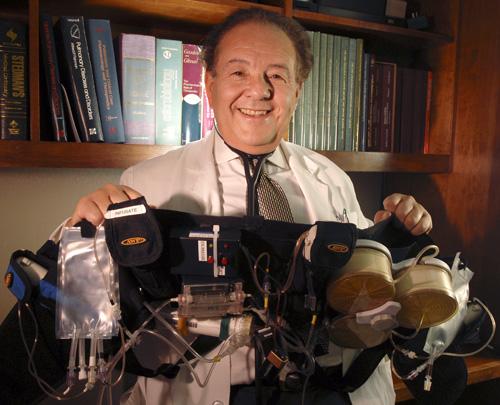Professor invents artificial kidney to improve lives

UCLA Associate Clinical Professor Victor Gura shows off a portable hemodialysis machine designed to filter waste from blood. Gura invented the device with the aim of allowing patients with kidney failure to treat themselves on a continual basis. Christopher Shane, Daily Bruin of UCLA
March 11, 2008
LOS ANGELES – The idea of someone’s blood being extracted from his body, filtered and returned while he is jogging, working or even making love may seem absurd to most.
To Victor Gura, an associate clinical professor at UCLA, this concept is very much a reality.
Gura has invented and is working on improving a device called a wearable artificial kidney that would make those suffering from kidney failure able to treat themselves on a continual basis.
Approximately 26 million people in the U.S. suffer from varying stages of chronic kidney disease, which can lead to end stage renal disease or total kidney failure, according to the National Kidney Foundation.
The role of the kidney is to purify the body’s blood of toxins such as urea and creatine. As a result, death may result from kidney disease.
Get The Daily Illini in your inbox!
When the kidneys fail, dialysis, a procedure by which a patient’s blood is cleaned through an external process, must be performed. There are two types of dialysis, said Thomas Morring, a dialysis nurse at the UCLA Dialysis Unit.
One type is called hemodialysis, which removes blood from the body and runs it through a solution of water and several vital minerals. The process is usually performed in a clinic for long periods of time, several times a week, and it often leaves patients worn out and tired from draining blood.
“Patients have a terrible life,” said Gura, who is also the chief medical officer at XCorporeal, a company that produces devices for kidney failure. “They have to spend enormous amounts of hours on the dialysis, stuck with needles three times a week.”
He also said that as functional kidneys purify the body’s blood continually, hemodialysis treatments tend to be quite inefficient.
“If you could do (dialysis) around the clock, it would be much less stressful for the body,” Morring said.
Peritoneal dialysis, the other form, involves running tubes through the abdomen’s membrane lining, which then acts as a filter to purify blood. This process often takes place several times a day but can be performed at home by the patient, said Dennis Roy, the director of U.S. home therapy products at Baxter Health Care Corporation, which sells home medical products, including dialysis devices.
Gura’s invention is essentially hemodialysis that can be done at home, like peritoneal dialysis, Roy added.
“We decided to take a 200-pound machine that looks like a washing machine and miniaturize it,” Gura said. “You can put it on your body and walk around with it.”
Gura said the purpose of the invention, which has not yet been developed for commercial sale, is to positively change the lives of those living with kidney failure.






